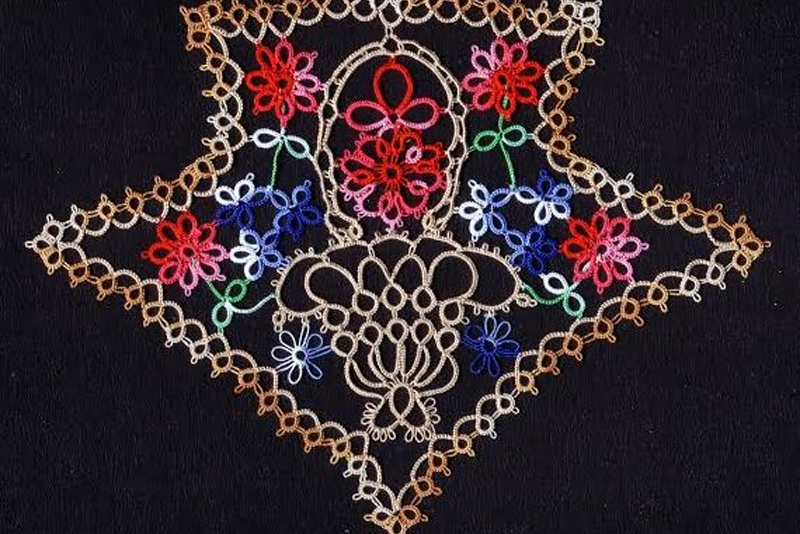Jan Stawasz is the premier tatting designer in Poland. Taught by a friend in 1992, Jan has been developing his tatting technique and design ever since. His designs have been published in Moje Robotki, Burda's "Anna", Igla i Nitka, Poradnik Domowy and the British Workbox, among others. Polish television broadcast his tatting course on air in 1995. The Polish Ministry of Culture and Art awarded him a scholarship in 1997 for his studies. He is also a co-author of the Polish Ministry of Labour and Social Policy's National Professional Qualifications Standard for "lacemaker."
Jan's book, "Tatting Theory and Patterns" (out of print) covers his method of tatting with close-up photos and detailed drawings of the technical instructions. The book has 30 diagrammed patterns including 12 doilies (many of his doilies are huge in size containing many rounds) , 5 necklaces, 2 collars, 6 window and Christmas-tree trimmings, 3 cloche hats in the European mode, a flower basket and a blouse. |
 |
He also posted a 22 min how to video at:
http://www.frywolitka.slupsk.pl/index_en.php?id=_film.
His website is: http://www.frywolitka.slupsk.pl/index_en.php
And contact info: jan.stawasz@frywolitka.slupsk.pl
The most important point of Jan's Method (http://www.frywolitka.slupsk.pl/index_en.php?id=_jans_method), is his placement of the picot in the middle of a double stitch between the first half stitch and the second half stitch. Most of today's tatting designers place the picot between the second half stitch and the first half stitch of the following double stitch.
To understand and tat his patterns we must be aware that the first dot (before a slash mark) indicates the first half stitch. The slash mark indicates a picot. A second dot (after a slash mark) calls for the second half stitch.
Jan's method brings to mind an oft discussed subject. What is meant by the first and second half stitch? These stitches were known earlier as the plain or the purl stitch, or the French stitch and the English stitch. In the Mlle Riego (Please see: http://www.bellaonline.com/articles/art70461.asp)patterns, her designations for the stitches were:
 reverse stitch = French stitch = first half stitch |
 single stitch = English stitch = second half stitch | Illustrations courtesy of Mark Myers, aka Tatman. |
It should be noted that Mlle Riego began her patterns with what we call the second half stitch today and the antique patterns do show this difference if examined closely. The Riego books are posted online for free download at http://www.bellaonline.com/content/link_list.asp?id=3137. And Mlle Riego, her tatting tools and method of working are mentioned in the article Civil War Tatting (http://www.bellaonline.com/content/link_list.asp?id=3138)by Virginia Mescher.
In that article Virgina Mescher writes: "Mlle. Riego’s method for tatting was very similar to our modern tatting, but at first she reversed her “stitches” or knots. Instead of making her double stitch as we do, she made our second stitch, (called the “French stitch”) first and our first stitch (called the English stitch) second, so that her knots, on the front, looked like our knots do on the back. Picots (sometimes called loops or pearl loops) were made between the first and second stitches of a double stitch, instead of between two double stitches, as we do today. Most other period tatting instructions have the reader make the English stitch first and the French stitch second, just as we do today."
Ms. Mescher's research indicates that Mlle Riego began tatting 2nd half stitch/1st half stitch and then later changed to 1st half stitch/2nd half stitch. See the Riego tatting instructions from "The Tatting Book" 1850 pg 6 and 7 (http://www.bellaonline.com/content/link_list.asp?id=3137).
Whichever method you use to tat just remember to keep your picots in the upright position. :)
Here's the latest article from the Tatting site at BellaOnline.com.
Julie Patterson - Three Books
These three books by Julie Patterson in Australia have long been out of print. The patterns are all easy to follow with clear diagrams and photos of the work. They have been brought back into print this week. They would be an excellent addition to any tatter's tatting reference library.
http://www.bellaonline.com/articles/art21948.asp
Please visit tatting.bellaonline.com for even more great content about Tatting.
To participate in free, fun online discussions, this site has a community forum all about Tatting located here -
http://forums.bellaonline.com/ubbthreads.php?ubb=postlist&Board=39
I hope to hear from you sometime soon, either in the forum or in response to this email message. I thrive on your feedback!
Have fun passing this message along to family and friends, because we all love free knowledge!
Georgia Seitz, Tatting Editor
http://tatting.bellaonline.com
One of hundreds of sites at BellaOnline.com







